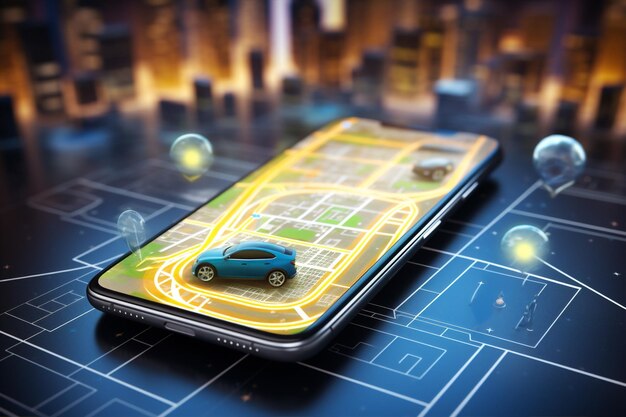Introduction
In today’s quick-paced world, convenience is the name of the game. Gone are the days when hailing a taxi involved standing on the curb, waving your hand, and hoping for the best. Thanks to the emergence of ride-hailing apps like Uber, Grab, and Lyft, as well as the cutting-edge field of Uber-like app development, booking a taxi has become a simple and effective procedure. In this article, we’ll dig into the complicated world of technology behind these applications and examine the essential elements and breakthroughs that have simplified taxi booking, from GPS tracking and mobile payments to sophisticated algorithms and user experience design.
1. GPS Technology and Real-Time Tracking
The core of any ride-hailing app is its ability to track the location of both drivers and passengers in real-time. This is made possible through Global Positioning System (GPS) technology. GPS allows the app to determine the precise location of a user’s device and the nearby drivers.
When a user requests a ride, the app uses GPS data to find available drivers in the vicinity. Once a driver accepts the ride request, the app continuously updates the user on the driver’s location and estimated time of arrival (ETA). This real-time tracking not only enhances user safety but also minimizes the uncertainty associated with traditional taxi services.
2. Algorithmic Matching
Efficiently matching riders with drivers is a complex task. It involves considering various factors such as proximity, traffic conditions, and the driver’s rating. Ride-hailing apps utilize sophisticated algorithms to make these decisions. The algorithms take into account multiple parameters, ensuring that the closest available driver is assigned to the user, and optimizing the overall user experience.
In addition to proximity, other factors like the user’s ride history, the driver’s rating, and traffic conditions are factored into the matching process. This ensures that passengers are matched with experienced and highly-rated drivers while considering the current road conditions.
3. User-Friendly Interfaces
A critical aspect of ride-hailing apps is their user-friendly interface. The success of these apps relies on their ability to cater to users with varying levels of tech-savviness. The design of these apps is focused on simplicity, ensuring that anyone can request a ride with minimal effort.
The user interface typically includes features like geolocation-based pickup, drop-off location input, fare estimation, and easy payment options. User feedback and iterative design have played a significant role in refining these interfaces, making them as intuitive as possible.
4. Cashless Payments
One of the game-changing aspects of ride-hailing apps is the transition to cashless payments. Users link their credit card or digital wallet to the app, eliminating the need for physical cash transactions. This innovation has not only made the payment process more convenient but also enhanced security for both riders and drivers.
Cashless payments also enable transparency, as the fare is calculated based on the distance and time of the trip. Passengers can see the exact fare before booking, reducing any potential disputes. Additionally, the ability to rate and tip drivers through the app further simplifies the payment process.
5. Dynamic Pricing (Surge Pricing)
While cashless payments bring transparency, ride-hailing apps have introduced dynamic pricing, often referred to as surge pricing. This pricing model adjusts fares based on supply and demand. When demand is high, such as during rush hour or inclement weather, prices can increase to encourage more drivers to be available.
Dynamic pricing helps balance the supply and demand equation, ensuring that users can find a ride even during peak times. However, it has also been a source of controversy, with some users feeling that they are being charged excessively. Ride-hailing companies have had to strike a delicate balance to maintain user satisfaction while keeping drivers available.
6. Driver Ratings and Feedback Systems
The concept of driver ratings and feedback systems is a fundamental element of ride-hailing apps. After each ride, passengers have the opportunity to rate their driver and provide feedback on their experience. Likewise, drivers can rate passengers. This two-way rating system ensures accountability and maintains a high level of service quality.
Drivers with consistently low ratings may be deactivated, promoting professionalism and good behavior among drivers. Passengers can also feel more secure knowing they can review the driver’s rating before accepting a ride. The feedback system is an integral part of maintaining a high standard of service within these apps.
7. Artificial Intelligence and Machine Learning
Artificial intelligence (AI) and machine learning (ML) are key technologies that underpin the success of ride-hailing apps. These technologies power various aspects of the service, from optimizing routes and matching passengers with drivers to fraud detection and customer support.
For example, AI algorithms can predict where and when rides are likely to be requested, helping drivers position themselves strategically. Additionally, ML models can detect unusual patterns or fraudulent activity, such as fake accounts or credit card misuse. Moreover, AI-driven chatbots and virtual assistants are used to enhance customer support by providing quick responses to user inquiries.
8. Safety Measures and Background Checks
Ensuring passenger safety is a top priority for ride-hailing companies. To achieve this, they implement rigorous safety measures, including background checks for drivers. These background checks involve screening for criminal records, traffic violations, and other potential red flags.
In some cases, ride-hailing companies have introduced features like emergency buttons within the app, allowing users to quickly contact law enforcement in case of an emergency. Additionally, some apps offer ride-sharing options that allow passengers to travel with friends or family members, enhancing safety further.
9. Regulatory and Legal Challenges
The rise of ride-hailing apps has not been without controversy. One of the significant challenges faced by these companies is navigating the complex regulatory landscape. Traditional taxi services are subject to various regulations and licensing requirements, and ride-hailing apps have often clashed with local authorities and taxi unions.
The ongoing legal battles and discussions have led to changes in regulations in many regions. Some cities and countries have created new rules specifically for ride-hailing services, attempting to strike a balance between safety, competition, and innovation.
10. Sustainability and Electric Vehicles
As environmental concerns grow, ride-hailing companies are also adapting to promote sustainability. Many companies have introduced electric vehicle (EV) options within their fleets. This move is not only environmentally friendly but also cost-effective in the long run, as EVs have lower operating costs.
In addition to electrification, ride-hailing apps are exploring other eco-friendly options, such as carpooling and shared rides. These services help reduce congestion and carbon emissions, aligning with broader sustainability goals.
Conclusion
The world of ride-hailing apps is proof of the revolutionary potential of technology. These platforms have completely changed the way we book and use taxi app development services, making the process more convenient, effective, and secure. From real-time matching algorithms and GPS monitoring to user-friendly interfaces and cashless payments, the tech behind these apps is a fascinating web of innovation.
While there have been difficulties, including legal and regulatory barriers, ride-hailing apps have demonstrated their ability to adapt and succeed. With the continued evolution of technology and a growing emphasis on sustainability, the future of taxi booking through Uber-like apps looks promising, with possibilities for additional improvements in both user experience and environmental effects.





